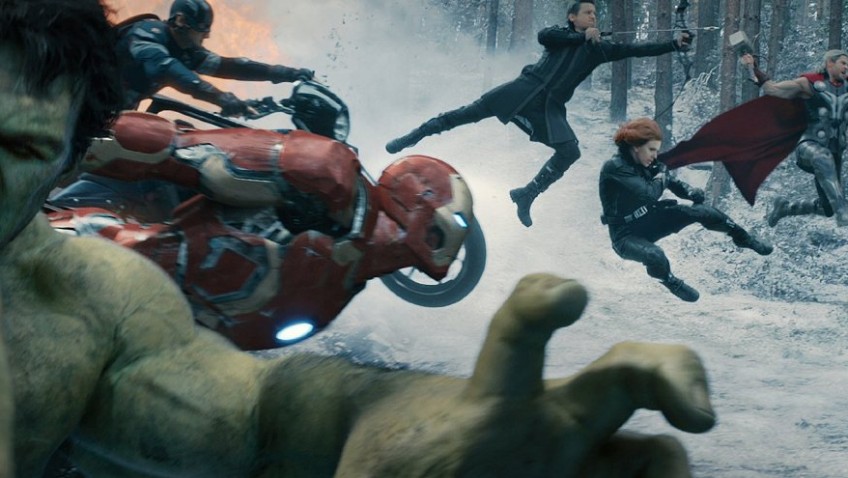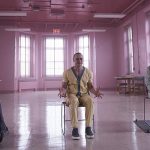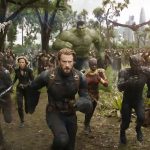Not long after Disney purchased Marvel Entertainment, they made the wise decision to invest a little more in Writer/Director Joss Whedon and a dream cast of versatile super actors. Whedon is an impossibly prolific and creative talent, but is perhaps best known for TV’s Buffy the Vampire Slayer and Angel and for Disney/Marvel’s first film venture, 2012’s Marvel comics’ superhero reunion, The Avengers Ensemble.
There are not many films that can start in medias res and plough forward without much explanation for the presence, let alone the motivation, of the eponymous villain Ultron (James Spader), a humanoid in a robot shell. On the back of the success of The Avengers Ensemble, a huge comic book fan base and a winning group of characters, The Avengers: Age of Ultron can get away with this and a lot more, but is not as much fun as the original.
The CGI battle that opens the film is the Avengers’ raid on a Hydra outpost, where mad scientist Baron Wolfgang von Strucker (Thomas Kretschmann) is experimenting on humans using Loki’s (see the last Thor movie) sceptre. Tony Stark, AKA Iron Man (Robert Downey Jr), and Dr Bruce Banner, AKA the Incredible Hulk (Mark Ruffalo), discover artificial intelligence within the sceptre and make clandestine use of it to build Stark’s Ultron global defence system, a kind of Trident Plus. Like in Frankenstein, the monster turns on his creator as Ultron emerges independently, believing that humanity must be destroyed to save the Earth.
Just when the Avengers appear outnumbered by Ultron’s flying robotic army, Vision (created by Ultron, but brought out of hiding by Stark and given life by Thor) comes to the rescue. Paul Bettany, known as the voice of Stark’s A.I. buddy, J.A.R.V.I.S, is finally given a body as the handsome, lithe android Vision, with, Thor points out, one of the six Infinity Stones (the most powerful object in the universe) on his forehead.
The plot will be more coherent to those who have not idle since The Avengers Ensemble, but who saw Captain America: The Winter Soldier; Iron Man 3, Thor: The Dark World and X Men: Days of Future Past. For one thing, you will have met Loki and, for another, you will remember Peter Maximoff (Evan Peters) in the last X Men as Quicksilver, a mutant who can think and move at the speed of light. Here he is played by Aaron Taylor-Johnson who is so good that he has been given a twin sister, Wanda, AKA Scarlet Witch (Elizabeth Olson).
These twins start off being servants to the destructive Ultron, but gradually see the light and join the side of the righteous. Scarlet Witch’s particular mind control powers means that she becomes more important as a weapon than Quicksilver. When still with Ultron, her job is to destroy through psychiatry. She gets into the heads of the heroes, like a dozen overdoses of Acid, making them confront their demons and leaving them vulnerable.
This is a clever device for building the characters, too, as we are able to learn more about what haunts them, what weakens them and what makes the team tick. This is how we learn of Black Widow’s background of abuse and coercion, Thor’s demons and Steve Roger’s AKA Captain America’s (Chris Evans) difficulty functioning with no military chain of command.
According to Whedon, the concept behind his hit television series Buffy the Vampire was ‘the idea of some woman who seems to be completely insignificant who turns out to be extraordinary.’ Buffy has gone on to influence many characters in successful fantasy franchises, including Scarlet Witch and Natasha Romanoff, the pretty, slight, young woman who transforms from a spy at the law enforcement agency S.H.I.E.L.D, into the deadly Black Widow when the Avengers call.
In fact, most of the characters in The Avengers: Age of Ultron, based on the Marvel Comics created by Stan Lee and Jack Kirby, are ‘ordinary people’ who turn into superheroes. Incredible special effects aside, Whedon’s main contribution to the franchise is to give more time to their ‘ordinary’ side.
So we have a build up in the romance between Natasha Romanoff and Dr Bruce Banner (Mark Ruffalo) that spills over into their superhero lives as Black Widow is the only one who can calm down Banner when he is transformed by violence into the Hulk. We also get a glimpse of Clint Barton’s AKA Hawkeye’s (Jeremy Renner) home life, even having dinner with his supportive wife and children when the Avengers seek refuge in his remote ranch.
It’s nothing unusual, but appears special to fans and to the cast who are accustomed to playing characters without real homes or families. We see the mythological Norse deity Thor (Chris Hemsworth) in modern clothing at a party; strained relationships between Stark and Dr Banner and a kind of identity crisis going on within Steve Rogers.
At the press conference, with all present but Hemsworth, the banter between the superhero actors was hilarious, and, curiously their comments were remarkably in character. When asked how it felt to be the sexiest superhero, Johansson retorted, ‘Haven’t you seen Chris Hemsworth?’ When asked to state his major influence, Chris Evans (squeaky clean Captain America) stated, ‘my dad’, while what excited egocentric Stark most was the full length mirror in the fitting room. The press conference left many us wishing than more of the spontaneous, sharp humour at the press conference had ended up in the film.




